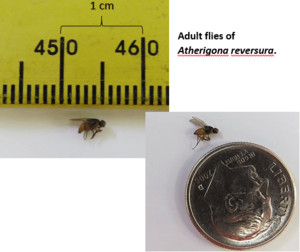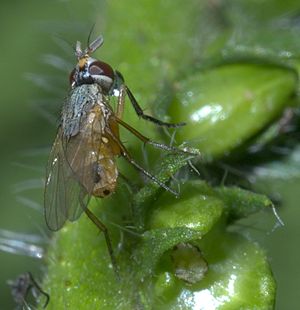Bermudagrass stem maggot facts for kids
Quick facts for kids Bermudagrass stem maggot |
|
|---|---|
 |
|
| Atherigona reversura | |
| Scientific classification | |
| Genus: |
Atherigona
|
| Species: |
reversura
|
The Atherigona reversura, also known as the bermudagrass stem maggot, is a type of fly that can be a big problem for farmers. It belongs to a group of flies called Atherigona, which has over 220 different species. Many of these species are known as serious agricultural pests. This specific fly gets its name because it loves to feed on bermudagrass (Cynodon dactylon) and stargrass (Cynodon nlemfuensis).
What Does It Look Like?
This fly is quite small. It has a head that looks a bit angular, and its wings are clear, almost see-through. The adult flies can be gray or yellow in color.
Male flies have a rounder body and are smaller than the females. Female flies have a larger, more pointed body. The young flies, called larvae, are white and shaped like a cylinder. They have special mouthparts, called mouthhooks, which they use to chew on the soft, new parts of grass shoots.
Where Does It Live?
The bermudagrass stem maggot originally comes from Central and Southeast Asia.
However, this fly was accidentally brought to Hawaii. There, it caused a lot of damage to turfgrass, which is the grass used in lawns and sports fields. In 2009, it was found in California. By 2010, it had spread to Georgia and southern Mexico. We don't know exactly how it spread so quickly. But the bermudagrass stem maggot has rapidly moved across the Southeastern United States. It causes big losses for farmers who grow grass for grazing animals or for hay.
How Does It Grow?
Scientists are still learning a lot about the life cycle of the bermudagrass stem maggot. We do know that the female flies lay their eggs on the underside of bermudagrass leaves.
About 2.5 days later, tiny larvae hatch from the eggs. These larvae then move to the part of the plant where the stem grows. They feed on this area, which causes the grass leaf to die. You can usually see this damage within 1 to 3 days.
After feeding, the larvae leave the stem and go into the ground. There, they change into a pupa, which is like a resting stage. After about 7 to 10 days, the adult flies emerge from the ground. Adult flies can live for about 21 to 28 days. During this time, they can produce many new offspring.
The number of bermudagrass stem maggots usually increases gradually from south to north. For example, populations start to grow in mid-June in Central Florida. They pick up later, in late July, in North Georgia.
Most types of bermudagrass can be damaged by this fly. However, the flies seem to prefer grass types that have many shoots, small shoot diameters, and narrow leaves.
To help control these flies, farmers are advised to harvest their grass. This helps to break the fly's life cycle. They might also apply special insecticides, called pyrethroid insecticides. These are usually used about 7 to 10 days after the grass has been cut and starts to grow back. Scientists are currently working hard to better understand how this insect pest behaves, its biology, and its environment.




